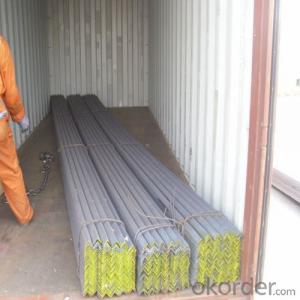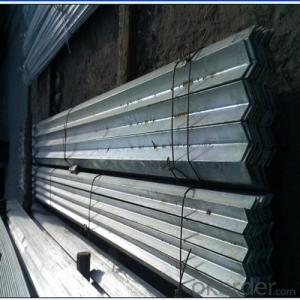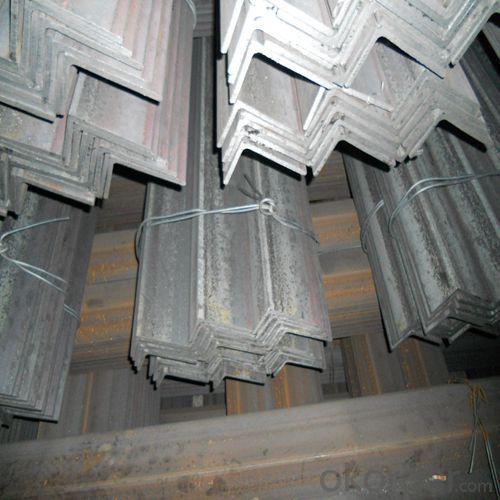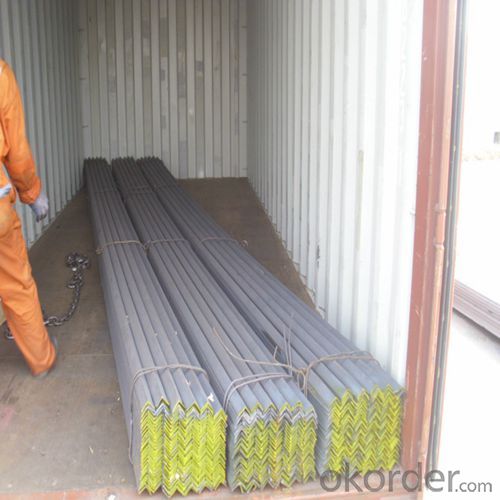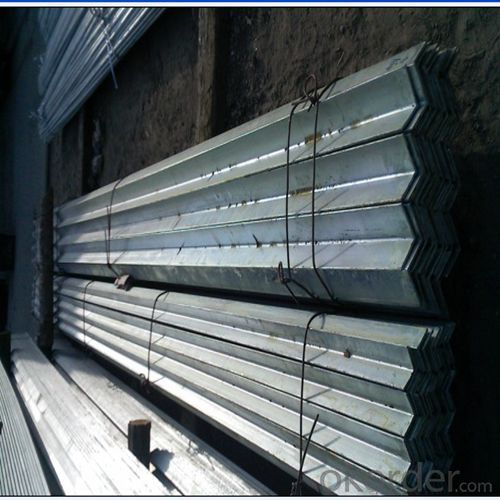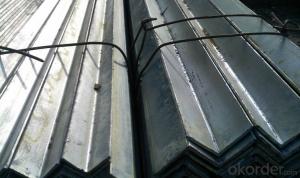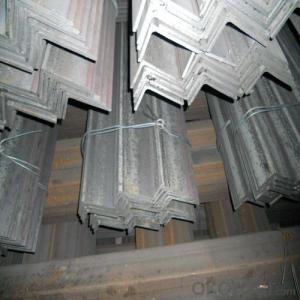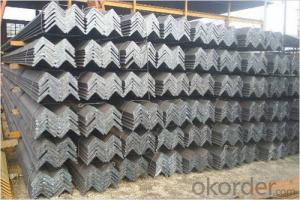Hot Rolled Steel Angle Euqal Angle Bar Uneuqal Angle Bar Q235
- Loading Port:
- Tianjin
- Payment Terms:
- TT or LC
- Min Order Qty:
- 50 m.t.
- Supply Capability:
- 50000 m.t./month
OKorder Service Pledge
OKorder Financial Service
You Might Also Like
Product Description:
OKorder is offering high quality Hot Rolled Steel I-Beams at great prices with worldwide shipping. Our supplier is a world-class manufacturer of steel, with our products utilized the world over. OKorder annually supplies products to European, North American and Asian markets. We provide quotations within 24 hours of receiving an inquiry and guarantee competitive prices.
Product Applications:
Hot Rolled Steel I-Beams are ideal for structural applications and are widely used in the construction of buildings and bridges, and the manufacturing, petrochemical, and transportation industries.
Product Advantages:
OKorder's Steel I-Beams are durable, strong, and resist corrosion.
Main Product Features:
· Premium quality
· Prompt delivery & seaworthy packing (30 days after receiving deposit)
· Corrosion resistance
· Can be recycled and reused
· Mill test certification
· Professional Service
· Competitive pricing
Product Specifications:
1.Grade: SS200,300,400 series
2.Size: 25×25×3 mm-100×100×10mm
3.Process: HRAP
4. Length: 2-6m
5. Shape: Equal
6. Delivery: within 20 days
7. MOQ: 1 ton
8. Certificate: ISO 9001:2008, SGS
9. Package:Standard Export Packing, or put into wooden boxes according to your requirement
10. Application: Construction, Marine, Industry and so on
Name | Stainless Steel Angles | ||||||
Standard | ASTM A554, A312, A249, A269 and A270 | ||||||
Material Grade | 304,316,201,202, 316L,430 | ||||||
Length | 6m or as customers' request | ||||||
Tolerance | a) thickness: +/-0. 15mm | ||||||
b) Length:+/-4. 5mm - 0mm | |||||||
Surface | 180G, 320G, 400G Satin / Hairline(Matt Finish, Brush, Dull Finish) 400G, 500G, 600G or 800G Mirror finish | ||||||
Application | Decoration construction, upholstery, industry instruments | ||||||
Test | Squash test, Extended test, Water pressure test, Crystal rot test, Heat treatment, NDT | ||||||
Chemical Composition of Material |
Composition
Material | 201 | 202 | 304 | 316L | 430 | |
C | ≤0.15 | ≤0.15 | ≤0.08 | ≤0.08 | ≤0.12 | ||
Si | ≤1.00 | ≤1.00 | ≤1.00 | ≤1.00 | ≤1.00 | ||
Mn | 5.5-7.5 | 7.5-10 | ≤2.00 | ≤2.00 | ≤1.00 | ||
P | ≤0.06 | ≤0.06 | ≤0.045 | ≤0.045 | ≤0.040 | ||
S | ≤0.03 | ≤0.03 | ≤0.030 | ≤0.030 | ≤0.030 | ||
Cr | 16-18 | 17-19 | 18-20 | 16-18 | 16-18 | ||
Ni | 3.5-5.5 | 4-6 | 8-10.5 | 10-14 | |||
Mo | 2.0-3.0 | ||||||
Mechanical Property | Material Item | 201 | 202 | 304 | 316L | ||
Tensile Strength | ≥535 | ≥520 | ≥520 | ≥520 | |||
Yield Strength | ≥245 | ≥205 | ≥205 | ≥205 | |||
Extension | ≥30% | ≥30% | ≥35% | ≥35% | |||
Hardness (HV) | <253 | <253 | <200 | <200 | |||
FAQ:
Q1: Why buy Materials & Equipment from OKorder.com?
A1: All products offered byOKorder.com are carefully selected from China's most reliable manufacturing enterprises. Through its ISO certifications, OKorder.com adheres to the highest standards and a commitment to supply chain safety and customer satisfaction.
Q2: How do we guarantee the quality of our products?
A2: We have established an advanced quality management system which conducts strict quality tests at every step, from raw materials to the final product. At the same time, we provide extensive follow-up service assurances as required.
Q3: How soon can we receive the product after purchase?
A3: Within three days of placing an order, we will begin production. The specific shipping date is dependent upon international and government factors, but is typically 7 to 10 workdays.
Q4: What makes stainless steel stainless?
A4: Stainless steel must contain at least 10.5 % chromium. It is this element that reacts with the oxygen in the air to form a complex chrome-oxide surface layer that is invisible but strong enough to prevent further oxygen from "staining" (rusting) the surface. Higher levels of chromium and the addition of other alloying elements such as nickel and molybdenum enhance this surface layer and improve the corrosion resistance of the stainless material.
Q5: Can stainless steel rust?
A5: Stainless does not "rust" as you think of regular steel rusting with a red oxide on the surface that flakes off. If you see red rust it is probably due to some iron particles that have contaminated the surface of the stainless steel and it is these iron particles that are rusting. Look at the source of the rusting and see if you can remove it from the surface.
Images:
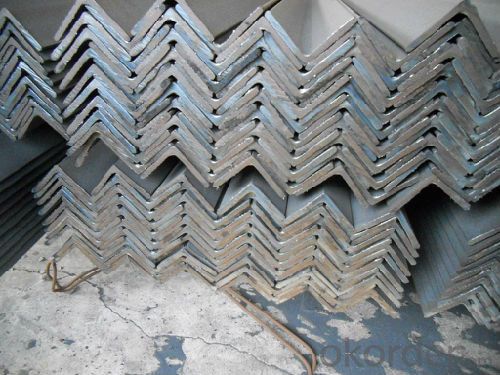
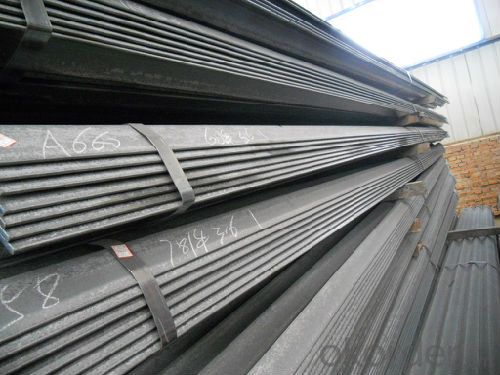
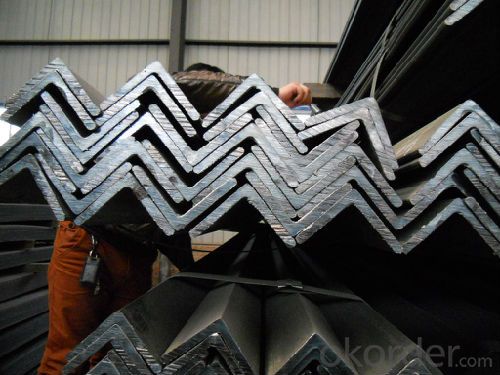
- Q: How do you calculate the strength of a steel angle?
- To calculate the strength of a steel angle, several factors need to be considered. The key parameters include the dimensions of the angle, the material properties of the steel, and the applied load or force. First, the dimensions of the angle must be determined. This includes measuring the length of both legs and the thickness of the angle. These measurements are essential for calculating the area moment of inertia, which is a crucial factor in determining the strength of the angle. Next, the material properties of the steel angle need to be known. This includes the yield strength, ultimate tensile strength, and the modulus of elasticity. These properties can be obtained from material specifications or testing. Once the dimensions and material properties are known, the strength of the steel angle can be calculated using various formulas and equations. One common approach is to calculate the section modulus, which is a measure of the resistance of the angle to bending. The section modulus can be calculated using the formula Z = (b × h^2)/6, where b is the thickness of the angle and h is the distance between the centroid of the angle to the outer edge. The strength of the angle can then be determined by comparing the applied load or force to the calculated section modulus. If the applied load is within the limits of the section modulus, the angle is considered to be structurally sound. However, if the applied load exceeds the section modulus, there is a risk of failure. It is important to note that the calculations for the strength of a steel angle are based on assumptions and ideal conditions. In practice, factors such as material imperfections, fabrication processes, and load distribution can affect the actual strength of the angle. Therefore, it is recommended to consult structural engineers or reference design codes to ensure accurate calculations and safe design.
- Q: What are the different methods of surface galvanizing for steel angles?
- There are several methods of surface galvanizing for steel angles, including hot-dip galvanizing, electro-galvanizing, and mechanical galvanizing.
- Q: What is the minimum thickness of a steel angle?
- The minimum thickness of a steel angle is typically determined by the standards and specifications set by the industry or governing bodies. These standards may vary depending on the intended use and structural requirements of the steel angle. In general, the minimum thickness of a steel angle can range from 1/8 inch to 1/4 inch, although thinner or thicker options may be available depending on the specific application. It is important to consult the appropriate standards or consult with a structural engineer to ensure that the chosen steel angle meets the required thickness for the desired application.
- Q: What is the maximum length of a continuous steel angle?
- Several factors determine the maximum length of a continuous steel angle, including its size, weight, transportation and handling limitations. Typically, the maximum length is restricted to what can be safely transported and handled by equipment like cranes or forklifts. This limit can vary based on the capabilities of the equipment and any transportation restrictions. The manufacturing process may also limit the length, as longer angles may be more challenging to produce or require specialized equipment. Ultimately, the maximum length should be determined based on the project's specific requirements and constraints, taking into account these factors.
- Q: Can steel angles be used for sign or billboard support structures?
- Steel angles can serve as support structures for signs or billboards. They are commonly utilized in construction due to their robustness and longevity. These angles offer exceptional support for a range of structures, including sign or billboard installations. They are adaptable and can be effortlessly customized and installed to meet the precise demands of the signage or billboard. With their ability to endure substantial loads and adverse weather conditions, steel angles are a perfect choice for supporting these structures. Moreover, they can be painted or coated to enhance their aesthetic appeal and shield them from corrosion, thus prolonging their lifespan.
- Q: What are the environmental impact considerations of using steel angles?
- The environmental impact considerations of using steel angles include the extraction and processing of raw materials, such as iron ore and coal, which contribute to deforestation, habitat destruction, and air pollution. Steel production also requires large amounts of energy, leading to greenhouse gas emissions and climate change. Additionally, the transportation and disposal of steel angles can further contribute to carbon emissions and waste generation. However, steel angles have a long lifespan and can be recycled, reducing the need for new production and minimizing their overall environmental impact.
- Q: What are the design considerations for incorporating steel angles into a structure?
- When incorporating steel angles into a structure, several design considerations need to be taken into account. First and foremost, the load-bearing capacity of the steel angles must be carefully assessed to ensure they can support the intended loads. The dimensions and thickness of the angles should be determined based on the structural requirements and anticipated stress levels. Additionally, the connection details between the steel angles and other structural elements need to be carefully designed to ensure they provide sufficient strength and rigidity. Considerations should include the type of fasteners, welding techniques, and any additional reinforcement required to achieve the desired structural integrity. Furthermore, factors such as corrosion protection, fire resistance, and durability should also be considered during the design process. Appropriate measures should be taken to prevent rust and corrosion on the steel angles, such as applying protective coatings or using stainless steel. Fire-resistant coatings or fireproofing materials may also be necessary, depending on the building's fire safety requirements. Lastly, aesthetics and architectural considerations may come into play when incorporating steel angles into a structure. The design should take into account the desired visual appearance, whether the angles will be exposed or concealed, and how they will integrate with the overall architectural style. In conclusion, the design considerations for incorporating steel angles into a structure involve assessing load-bearing capacity, connection details, corrosion protection, fire resistance, durability, and aesthetic integration.
- Q: What are the different surface finishes available for galvanized steel angles?
- Galvanized steel angles come in a variety of surface finishes to suit different needs and preferences. 1. The smooth surface finish is the most commonly used for galvanized steel angles. It gives a polished and sleek appearance, making it suitable for various applications. 2. For those concerned about glare, a matte finish can be achieved by applying a chemical treatment to the angles. This provides a non-reflective surface. 3. Textured finishes involve adding patterns to the surface of the angles. This can be done through embossing or applying a textured coating. The textured surface not only enhances grip but also adds a decorative element. 4. Powder coating is another option for galvanized steel angles. This involves applying a dry powder to the surface and then curing it in a high-temperature oven. It offers a durable and attractive finish, with a wide range of color options available. 5. Painting is also possible for galvanized steel angles, using either oil-based or water-based paints. This adds an extra layer of protection against corrosion and can be customized to match specific color requirements. When choosing a surface finish for galvanized steel angles, it is important to consider the intended use, aesthetic preferences, and the level of protection required against corrosion. Environmental conditions and specific application needs should also be taken into account.
- Q: Can steel angles be used for sign posts?
- Certainly! Sign posts can indeed utilize steel angles. Due to their robustness and endurance, steel angles are frequently employed in construction. They can effectively offer the required support and stability for sign posts, particularly in regions prone to strong winds or heavy traffic. Moreover, the versatility of steel angles shines through as they can be effortlessly welded or bolted together, presenting an adaptable choice for sign post installation. Furthermore, their immunity to corrosion guarantees a lengthier lifespan, thereby diminishing expenses associated with maintenance and replacement.
- Q: Can steel angles be used in industrial or heavy-duty applications?
- Yes, steel angles can be widely used in industrial or heavy-duty applications due to their high strength, durability, and versatility. They are commonly utilized in construction, infrastructure, manufacturing, and fabrication industries for various purposes such as supporting structures, framing, bracing, and reinforcement. Their ability to withstand heavy loads and provide stability makes them suitable for demanding environments where strength and resilience are crucial.
Send your message to us
Hot Rolled Steel Angle Euqal Angle Bar Uneuqal Angle Bar Q235
- Loading Port:
- Tianjin
- Payment Terms:
- TT or LC
- Min Order Qty:
- 50 m.t.
- Supply Capability:
- 50000 m.t./month
OKorder Service Pledge
OKorder Financial Service
Similar products
Hot products
Hot Searches
Related keywords

